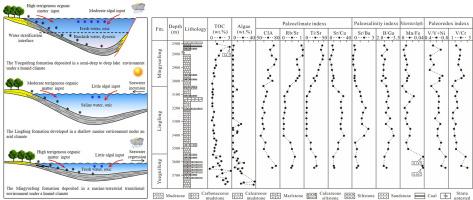Paleoclimatic and paleoenvironmental constraints on organic matter enrichment in the Paleocene strata in the Lishui Sag, East China Sea Shelf Basin
IF 3.6
引用次数: 0
Abstract
Using major and trace element analyses, this study investigated the impacts of paleoclimatic and paleoenvironmental variations on organic matter enrichment in the Paleocene Yueguifeng, Lingfeng, and Mingyuefeng formations in the Lishui Sag, East China Sea Shelf Basin. Multiple geochemical proxies suggest that during the deposition of the three formations, the paleoclimate evolved from a humid climate to an arid and then back to humid conditions, the paleosalinity conditions underwent brackish, saline, and fresh water sequentially, and the paleowater conditions shifted from relatively deep water to relatively shallow water and then to shallow water. Accordingly, the water column evolved from reducing to oxidizing and then to weakly oxidizing to oxidizing conditions. Organic matter productivity, as well as the preservation or degradation of organic matter, was controlled by covariation in the paleoclimatic and paleoenvironmental conditions. This can account for the difference in organic matter enrichment in the mudstones of the three formations. The mudstones in the Yueguifeng Formation were deposited in a semi-deep- to deep-water lacustrine environment with high primary productivity in a warm, humid climate. Numerous planktonic algae were efficiently preserved in stratified and dysoxic water columns, resulting in high organic matter enrichment in this formation. The mudstones in the Lingfeng Formation were formed in a shallow marine environment with low primary productivity in an arid climate. The combined effects of high salinity and oxygen-enriched conditions in the water bodies were unfavorable for the reproduction and preservation of planktonic algae, resulting in low organic matter enrichment. For the Mingyuefeng Formation, the slow tectonic subsidence and flat topography during the deposition of this formation led to the development of a swamp environment in a warm, humid climate. The swamp environment was characterized by an oxic water column, low aquatic organic matter input, and high terrigenous organic matter input. The Yueguifeng Formation has greater hydrocarbon-generating potential than the Lingfeng and Mingyuefeng formations. Constructing the developmental models of organic-rich mudstones based on the covariation in the paleoclimatic and paleoenvironmental conditions represents a valid method for understanding the hydrocarbon-generating potential of these source rocks.

东海陆架盆地丽水凹陷古新世有机质富集的古气候古环境制约因素
采用主量元素和微量元素分析方法,研究了东海陆架盆地丽水凹陷古新世月桂峰组、凌峰组和明月峰组有机质富集的古气候和古环境变化。多种地球化学指标表明,在三组沉积过程中,古气候经历了从湿润气候到干旱气候再回到湿润气候的演化过程,古盐度条件经历了咸淡水-咸水-淡水的顺序,古水条件由相对深水-相对浅水-再到浅水的变化过程。相应的,水柱从还原性到氧化性再到弱氧化性再到氧化性。古气候和古环境条件的共同变化控制着有机质的生产力和有机质的保存或降解。这可以解释三组泥岩有机质富集程度的差异。岳桂峰组泥岩沉积于温暖湿润的半深-深水湖相环境,初级生产力高。大量的浮游藻类被有效地保存在分层和缺氧的水柱中,导致该地层的有机质富集程度很高。凌峰组泥岩形成于干旱气候下初级生产力较低的浅海环境。水体高盐度和富氧条件的共同作用不利于浮游藻类的繁殖和保存,导致有机质富集程度低。明月峰组沉积期间缓慢的构造沉降和平坦的地形导致其形成温暖湿润的沼泽环境。沼泽环境以含氧水柱、低水生有机质输入、高陆源有机质输入为特征。月桂峰组比凌峰组和明月峰组具有更大的生烃潜力。基于古气候和古环境条件的共变,构建富有机质泥岩发育模式,是认识这些烃源岩生烃潜力的有效方法。
本文章由计算机程序翻译,如有差异,请以英文原文为准。
求助全文
约1分钟内获得全文
求助全文

 求助内容:
求助内容: 应助结果提醒方式:
应助结果提醒方式:


